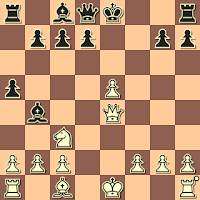While The Database contains all of the historical over-the-board and correspondence games that I have been able to collect, and, no doubt, suffers slightly from the fact that players are willing to share or publish their successful efforts, while letting their unsuccessful ones remain unnoticed - a full 93% of the games are drawn, regardless of their outcome, from games played at the online chess website FICS, at all time controls, from 1999 through September 2018.
That means that The Database largely reflects the experiences of the average online club player playing the Jerome Gambit.
So - how are the results of the Jerome Gambit (and for this question, I focused upon just 1.e4 e5 2.Nf3 Nc6 3.Bc4 Bc5 4.Bxf7+) doing? Are we, as Jerome Gambit players, getting better over time?
This is what I found.
Year Games Score
1999 29 34%
2000 172 41%
2001 262 40%
2002 231 44%
2003 242 34%
2004 251 38%
2005 383 37%
2006 502 38%
2007 560 39%
2008 782 43%
2009 1,322 45%
2010 930 40%
2011 1,073 42%
2012 634 45%
2013 945 44%
2014 867 43%
2015 589 43%
2016 621 45%
2017 589 44%
2018* 389 45%
(*2018 includes games from January - September.)
("Scoring" is calculated by assigning one point to each win, one half point to each draw, and dividing by the number of games played.)
Another way of looking at the data is to graph the scoring percentages (which show a general trend upward):
There are any number of ways to look at this data.
Perhaps the simplest is to guess that players who are unsuccessful with the Jerome leave the pool (and produce no more games), while players who are successful stick around, adding more wins and bumping up the scoring percentage. Following this logic, though, it is not clear why the number of soon-to-be-unsuccessful players who played the Jerome Gambit in 1999 (and subsequently left the pool) should be any different than the soon-to-be-unsuccessful players who try their hand in 2019 (joining the pool, replacing those who left).
Maybe the Jerome Gambit, in general, is better known today than it was 20 years ago. (This blog and I will take some of the blame.) It is a risky and exciting opening, so, perhaps more sedate players who would find it not to their taste now steer clear (avoiding adding losses to The Database), while the adventurous swash-bucklers, knowing what they are getting into, charge straight ahead, nonetheless (adding wins, and possibly getting better over time).
Even though the scoring percentage for the Jerome Gambit remains quite modest, compared to many other openings, there are some super-players who do quite well with the opening. Quite possibly, the trend upwards of scoring reflects their entry into FICS play, and their improvement over time?
In the end, we must always remain careful about statistics - and refuted chess openings.































